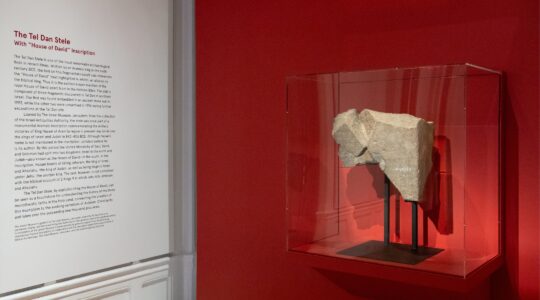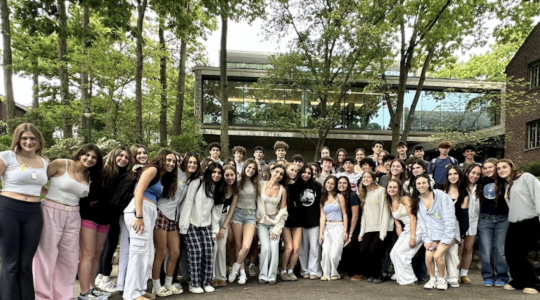Conversation with painter Archie Rand is multilayered and goes in varied directions, but often swings back to the Jews and Judaism. He’s not a religious man, nor a biblical scholar, but his interests in Jewish texts run deep. Over his distinguished and highly recognized career, Rand has worked to create a Jewish iconography, often combining words and images in vibrant, daring paintings.
His new book, “The 613” (Blue Rider Press/Penguin Random House), presents colorful, attention-grabbing scenes, with each full page dedicated to one of the 613 mitzvot, commandments (also translated as good deeds), in the style of graphic literature.
Rand didn’t begin as a Jewish painter, a label that he wears happily. As a young man of 18, he had his first show at the Tibor de Nagy Gallery, and he commanded the attention of serious critics for his abstract works. He became more interested in affixing meaning to his abstract work and began painting more figuratively and more religiously, and in the 1970s began doing more Jewish-related work. In 1974, he was commissioned to do a series of murals for Congregation B’nai Yosef, a Syrian shul in Brooklyn.
Since that first show in 1966, he has had more than 100 solo shows and has been featured in more than 200 group shows, but he feels that once he turned to religious themes, the critics and curators, many of whom were Jewish, paid less attention. He says, “It was almost like what the Soviets would do when people weren’t good Communists. You disappeared. You weren’t killed, but it was as though you evaporated.”
What happens, he continues, is that an artist then gets to do what he wants. Rand has done many other series of paintings, including his 54 parsha paintings, based on the weekly Torah readings; his 39 forbidden labors on Shabbat; 60 scenes from the Bible as graphic art; 12 prophets and 19 works based on the Amidah in the prayer service.
“A series gives me the opportunity to invest in a large narrative,” he says.
Turning to “The 613,” he says, “I swiped the images, mostly from EC Comics. A very Jewish source. Also from Mad Magazine and its progeny.”
The paintings are not meant to be illustrative, and he resists talking about how his images relate to the texts. He prefers that the viewer figure it out, or at least start thinking about it and asking questions. In painting, he worked intuitively, after doing much reading and research. The colors are warm and bright, with a joyous, expressive quality about them — the book is a feast of images. Some of the settings are contemporary, while others appear out of time. There’s humor, but the artist works without irony.
In #70, a blonde woman dries dishes, “Men must not wear women’s clothes” (Deuteronomy 22:5); a different young woman appears full of gratitude in #270, “To bring the first fruits into the Temple” (Exodus 23:19); a black-hatted villain standing on a wharf points a gun in #476, “Not to covet or scheme to acquire another’s possession” (Exodus 20:14); a black-hatted cowboy tries to capture a horse, “The king must not have too many horses” (Deuteronomy 17:16); and a man and woman step in a dancer’s embrace, #582, “Not to curse your father and mother” (Exodus 21:17).
Musing about why he took on this project, he says, “I don’t know, I just got this message in my head, I had to do it, for better or worse. It’s what happens to the artist. I found that this had many more avenues of discovery than formal, theoretical or structural paths that I had a pretty good purchase on.”
Rand worked on this series from 2001 to 2006, when he also had other projects and shows going on. While there are 613 (actually 614, including an additional cover image) canvases, Rand sees the project as one painting, one statement. In fact, he describes himself as a mural painter. In 2008, he assembled the series on a wall in his warehouse, and it measured 17 feet high by 100 feet long. For four hours that day, he opened the studio — more than 1000 people came to view it. The series will be exhibited again in its entirety at the Contemporary Jewish Museum in San Francisco in 2017.
The book version is different in that the texts are added to each page, along with the citation. The paintings have what he calls a “meditative hum” – each has a gold frame around it, reflecting the light, and he adjusted the color in the book to maintain the raucous quality.
Support the New York Jewish Week
Our nonprofit newsroom depends on readers like you. Make a donation now to support independent Jewish journalism in New York.
“I want people viewing this to have the smell of herring, to be all the things that people are afraid of being Jewish, that’s garish and vulgar, whatever you would apply to an immigrant group that the city at large finds discomfiting.”
Rand, now the Presidential Professor of Art at Brooklyn College and previously head of the department of visual art at Columbia University, has lived and worked in Brooklyn for his entire life, except for a brief period in Manhattan’s Soho. He found Brooklyn more conducive to serious work, and returned. For about 40 years, he has lived and worked in Sunset Park.
Sloping down toward the nearby East River, his street is lined with low apartment buildings, row houses, and Latin American and Pentecostal churches, many decorated festively for the season. His home, built in 1905 as a stately Lutheran church for what was then a heavily Scandinavian community, was later a gambling and dance hall run by the Veterans of Foreign Wars. His painting studio is upstairs, in what used to be the church sanctuary.
“Brooklyn has great attitude,” he says. “I love Brooklyn.”
His full name is Arthur Spencer Rand; the Spencer is after Sprintza, but he has long been Archie. His grandparents came from Poland on his paternal side, Odessa and Kiev on his mother’s. Born in 1949, he grew up in postwar Bensonhurst, “bookended in popular culture between Ralph Kramden’s rants and John Travolta’s dance,” as he writes in the book’s introduction. He attended public schools and afternoon Hebrew School, and then Lafayette High School. “Anything was possible. We all felt it. Ambition and nerve were in the air. It was a hotbed of wise guys.”
He says that he hung out with a bunch of wise guys and then when he decided that he no longer wanted to be a juvenile delinquent, he took on affects of a French intellectual, trading his leather jacket for a woolen jacket, beret and pipe. He graduated high school at 15. The previous year, he met a classmate named Maria, and borrowed a set of opera tickets from his grandfather for their first date. She’s now his wife.
Maria, who recently retired as director of Brooklyn College’s Art Gallery, joins her husband at the kitchen table and our artful conversation first detours to stories of Sicily, where she was born. She came to the U.S. as a young girl and was raised Catholic. Her family didn’t at all object when she converted to Judaism, and she and Archie have since pieced together bits of her family’s history to determine that her roots are indeed Jewish and that many in her hometown are the descendants of hidden Jews who fled the Inquisition. The Rands now have a home in Sicily and their grown children, who graduated from the Yeshivah of Flatbush, are fluent in Hebrew and Sicilian dialect.
Their house is gallery-like, its high walls filled with Rand’s paintings, some very large, and other works by artists that he admires, including Alexander Calder, Giorgio de Chirico, Max Beckmann, Art Spiegelman, Philip Guston and R.B. Kitaj. Kitaj was a friend who encouraged him to do the 613 project, and later Kitaj wrote his “Second Diasporist Manifesto” in 615 verses, relating to the 613 commandments.
Upstairs, the artist’s studio is filled not only with canvases from his many projects, but also with stacks and shelves of books of all kinds. He shows a visitor paintings from two series he hasn’t yet exhibited, one about the Ten Plagues. The other is a series of portraits of 10 Jewish painters, done in 2014, including Marc Chagall, Will Eisner, Eva Hesse, Barnett Newman and Maurice Sendak, each filled with images close to the individual, like Chagall’s violin, Sendak’s crown and a piece of string affixed to Hesse’s portrait. These are beautiful paintings full of light and life, marked with Rand’s imaginative impulse. I look forward to encountering this minyan again on a museum wall.
The New York Jewish Week brings you the stories behind the headlines, keeping you connected to Jewish life in New York. Help sustain the reporting you trust by donating today.




